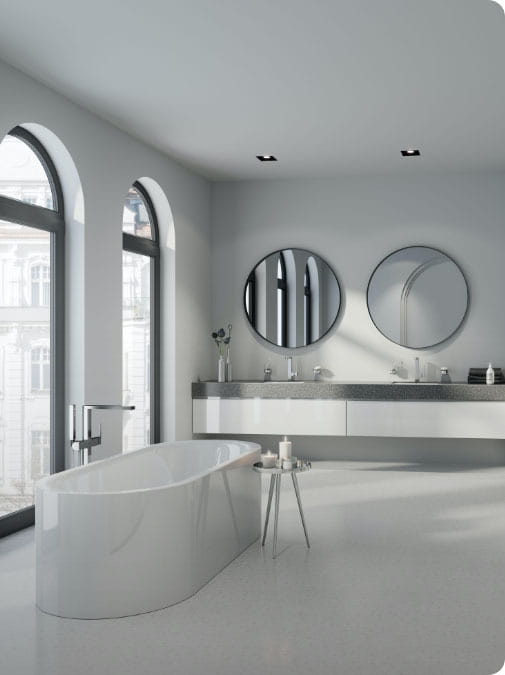American Standard Low-Flow Toilets Help Save Water and the Environment in New York City
To view the video of this story, click here.
In response to the critical need for the Delaware aqueduct in New York state to shut down for necessary repairs, American Standard provided the water-saving plumbing solution ― and helped the environment, all at the same time.
Carrying nearly half of New York City’s water, the aqueduct’s upcoming closure presented a serious problem. In response, officials at the New York City Department of Environmental Protection (DEP) developed a water demand management plan aimed at saving 25 million gallons of water per day. They identified the New York Department of Education (DOE) ― with its 1,300 facilities serving 1.1 million students ― as a target for achieving significant water efficiencies.
“One of the biggest ways to save water is by replacing old, inefficient toilet fixtures,” said Ben Huff, DEP project manager. “We estimated that by replacing the DOE’s roughly 30,000 fixtures, we could save about four million gallons of water per day.”
The initiative began in 2016 with the goal of replacing water-guzzling fixtures in the 500 largest DOE buildings. The existing toilets, dating back to the pre-1980s, flushed at 5.0 gallons per flush (gpf), consuming nearly four times the preferred high-efficiency 1.28 (gpf) of toilet models generally installed today. However, the existing 3-bolt wall-mounted models in NYC schools presented a unique retrofit challenge: replacing them would potentially involve breaking wall tiles for drilling of additional bolts. That’s where American Standard provided the optimum solution.
In order to simplify the remodeling project, the DOE and DEP selected the American Standard 3-bolt model Rapidway elongated commercial toilet, known for its durability and high performance, for this high traffic public school setting.
“The DOE trusted our brand, but also had a practical, water- and labor-saving need for efficient, 3-bolt models,” explained Michelle Roberts, senior national multi-unit segment leader for LIXIL Americas, the division under which American Standard operates.
Plus, the wall-hung Rapidway toilets are ADA-compliant, making them easier, safer, and more comfortable to use for students and faculty with limited mobility. Helping achieve the water reduction goal for the city, these toilets were installed with 1.28 gpf flush valves, resulting in a roughly 75 percent reduction in water usage.
A New Life for Old Toilets
Before the new, water-efficient Rapidway toilets could go in, the old, 5.0 gpf models had to come out. Rather than consign these thousands of chinaware fixtures to a landfill, the DEP developed a sustainable, environmentally-friendly solution that was a win-win for all involved. A concurrent initiative was underway to build an oyster reef at nearby Jamaica Bay on Long Island. The Office of Ecological Services proposed that the porcelain from the old toilets could be crushed and used as a base for this oyster reef, which would help prevent erosion and act as a natural water filter.
Both the DEP and DOE liked the idea of the fixtures having a second life to benefit the environment. But preparing the chinaware for its new purpose was not as simple as merely smashing the toilets to bits. Workers first power washed the used toilets to eliminate as much dirt as possible; then they removed all metal and plastic parts; and then they smashed the porcelain into pieces, in the correct size to work best as the oyster bed base. The last step involved leaving the heaps of broken toilet porcelain out in the rain and sunlight for further cleansing. Although it was a labor-intensive process, it did produce the ideal material for the Jamaica Bay oyster reef, which is currently in place and growing.
Building Bioswales from Porcelain
With more porcelain collected than was needed for the oyster reef, the Office of Green Infrastructure proposed another sustainable solution. As part of its environmentally-friendly landscape design, New York City has been creating thousands of bioswales throughout the community. These urban rain gardens, traditionally filled with crushed stone, are part of a stormwater management system that aims to collect water runoff from the street. The clean, broken-up toilet pieces could serve the same purpose, being very similar in quality, size and shape as the crushed stone requirements. By allowing excess water to soak naturally into the ground, the crushed porcelain now helps prevent sewer overflow that can be harmful to the New York harbor water quality. The used toilets received a second life and now play an important role in preventing flooding and erosion.
Sustainability is Ongoing
Currently, the effort to replace all 30,000 chinaware fixtures in the DOE facilities is ongoing in New York City. The DEP has set a goal of replacing fixtures in another 80 to 100 schools through 2018. All the hard work is made easier with the knowledge that it’s for a good cause. While the new, high-efficiency fixtures from American Standard reduce water usage in New York’s schools, the remnants from the old toilets will help preserve the environment on the city’s streets and shores.
###


